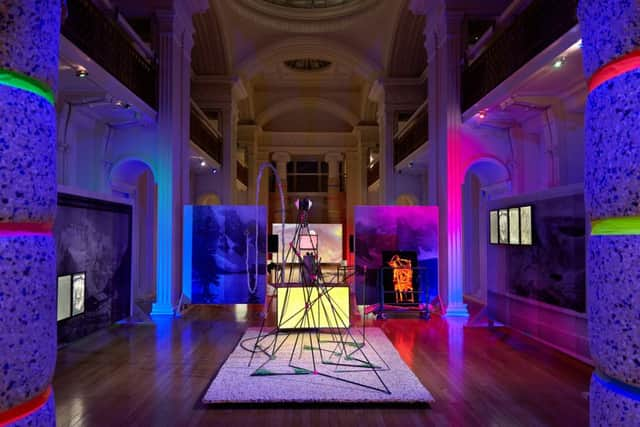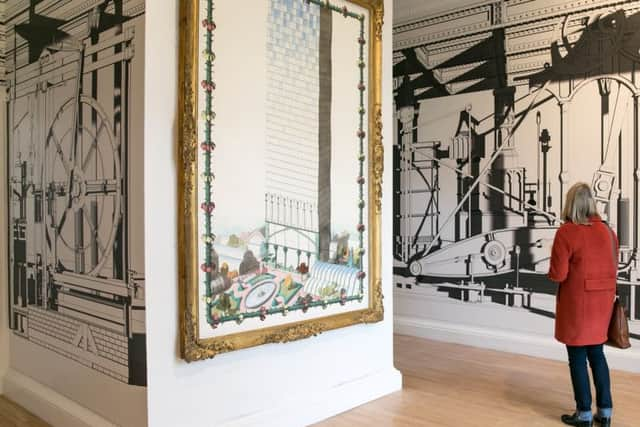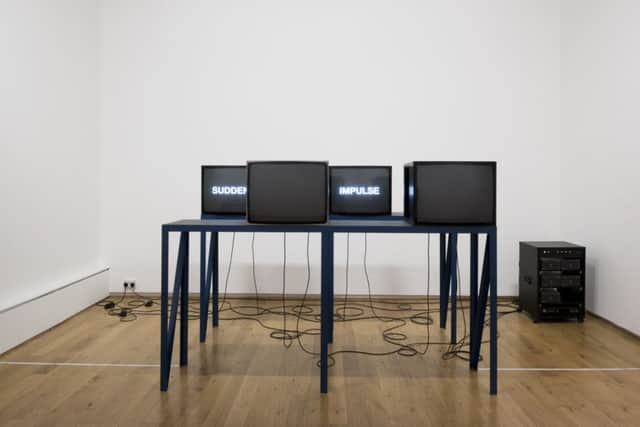Art review: British Art Show 8 takes over Edinburgh


In the Royal Botanic Garden in Edinburgh someone is lurking in the shrubbery. Or, to be more precise, there are a number of somebodies hiding amongst the glossy green specimens in the magnificent Victorian Palm House.
Among the feathered trunks and dense green leaves you catch a glimpse of a baseball hat, a ceramic packet of fags tucked in a back pocket. Artist Jesse Wine’s figurative sculptures are suspended like Alexander Calder’s famous modernist mobiles. But where Calder opted for primary colours and simple geometric shapes, Wine uses pressed, rolled and painted ceramic to evoke the everyday: a hoodie here, a pair of hands there.
Advertisement
Hide AdAdvertisement
Hide AdWine is a sculptor who uses ceramics rather than a ceramic artist who makes sculptures, and so he fits almost perfectly into the professed curatorial brief of the British Art Show 8, which is about ways of making and materiality in the digital age.


British Art Show 8 | Rating: **** | Talbot Rice Gallery, Edinburgh
British Art Show 8 | Rating: **** | Inverleith House, Edinburgh
The difficulty of imposing a curatorial rubric on 42 very different artists is a perennial problem for this touring exhibition of contemporary art, which in its visit to Edinburgh sees it take over three different venues – Inverleith House, Talbot Rice and the Scottish National Gallery of Modern Art (the latter reviewed last week).
One might have thought it was obvious that what artists did was make material stuff, but the educational emphasis during the last two decades has largely been on thinking and context. Those artists who aren’t busy at their Apple Macs all day are wondering what happens to the analogue world during the age of digital dominance. Ever perverse, it seems that half of them are busy making macramé or teaching themselves pottery, print-making and other delightfully obsolete skills: an intellectual detour as they try to find an alternative route around our virtual universe.


There are moments where this works: Hayley Tompkins’ paintings and collages at the Talbot Rice, for example, where industrial machinery rubs up against acrylic paint. Or Pablo Bronstein’s arch but beautiful industrial-themed wallpaper at Inverleith which imagines what might happen if William Morris had embraced the joys of the machine age instead of papering it over with English orchards and poppies.
I think making is a real problem for younger artists, educated in what is called the post-medium age, when they approach craft or art form specialisms from the outside. Like Wine, they know enough about their materials to make craft look funny or sly or abject, or even at it’s best expressive. But it’s rare that they know either so little or so much that they make things that feel genuinely subversive. The ever-present danger is a hipster whiff of acquired authenticity, rather than the astute punk amateurism that I think an artist like Wine might genuinely achieve.
Advertisement
Hide AdAdvertisement
Hide AdNostalgia is the genuine and riveting subject of Charlotte Prodger’s sound and video installation Northern Dancer. Using reconditioned Hantarex monitors, the boxy electronic screens that dominated railway station information systems and avant-garde art exhibitions in the 80s and 90s, Prodger’s work juxtaposes spoken word and text.
The bold and evocative words that flit in monochrome sequence along the marshalled rank of screens are the pedigree names of racehorses. Spoken in Prodger’s own voice (a frequent presence and significant authorial asset in her work) the text is a gentle evocation of a brutal story: the avant-garde writer Gertrude Stein’s decision to excise every example of the word “may” from a text when she was dumped by a lover of the same name.


Prodger’s recent bodies of work can be thought of in lots of ways, among them queer politics and techno fetishism, but for all its apparent coolness Northern Dancer’s wider emotional pull is curious. How do we think about ourselves in relation to others and how do we mark their loss or disappearance? Are we the sum of our constituent parts or made by our experiences? Are we free to remake ourselves, to cut out our failings or excise those who have failed us?
Down in the basement of Inverleith House, Patrick Staff’s film also looks at gay history and to the generational gaps in its telling. Based on a visit to the Tom of Finland Foundation it articulates the liberating power that the late artist’s notorious homoerotic drawings had on an older generation of men.
These days Tom of Finland looks like a historical curio, but in the gentle daily life of the Foundation juxtaposed with the hysterically pumped up imagery of the artist’s canon, Staff finds cross-generational understanding and a kind of accommodation and respect expressed through dance.
These kind of interweaving narratives were lost in the British Art Show 8’s first outing in Leeds last autumn. In Edinburgh, however, the show has expanded both physically and intellectually as it spreads out to fill its handsome and notably historic venues.


This is nowhere more obvious than in the grand Georgian Gallery at the Talbot Rice, where the gorgeous 18th century architecture has been overwhelmed by the pulsing neon chaos of Benedict Drew’s work Sequencer, vastly more satisfying than when I last saw it. It is a veritable orgy of sound and vision, and a heck of a lot of awkward cabling as well as host of monitors and upturned screens, each screaming in psychedelic hues.
Advertisement
Hide AdAdvertisement
Hide AdIn a sequence of cleverly staged sequences, Drew contrasts traditional issues of the sublime in art, grand alpine scenes and millennia of geological formations, with the heady yet controllable output of the digital world.
In a kind of joyful squeamishness, you want it all to stop. Drew has been audacious enough to wrap the gallery’s fine Georgian pillars in underlay and luminous tape. They look just great.
• Until 8 May